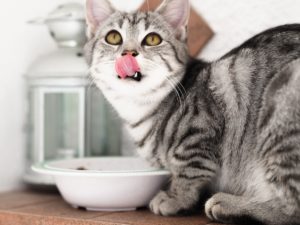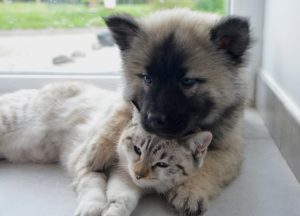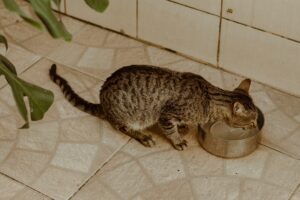If you have been a cat owner for years, you have probably spotted your beloved one producing a puddle of vomit at least once… However, this is not something to be surprised by. Our pets can get sick once in a while just like we do!
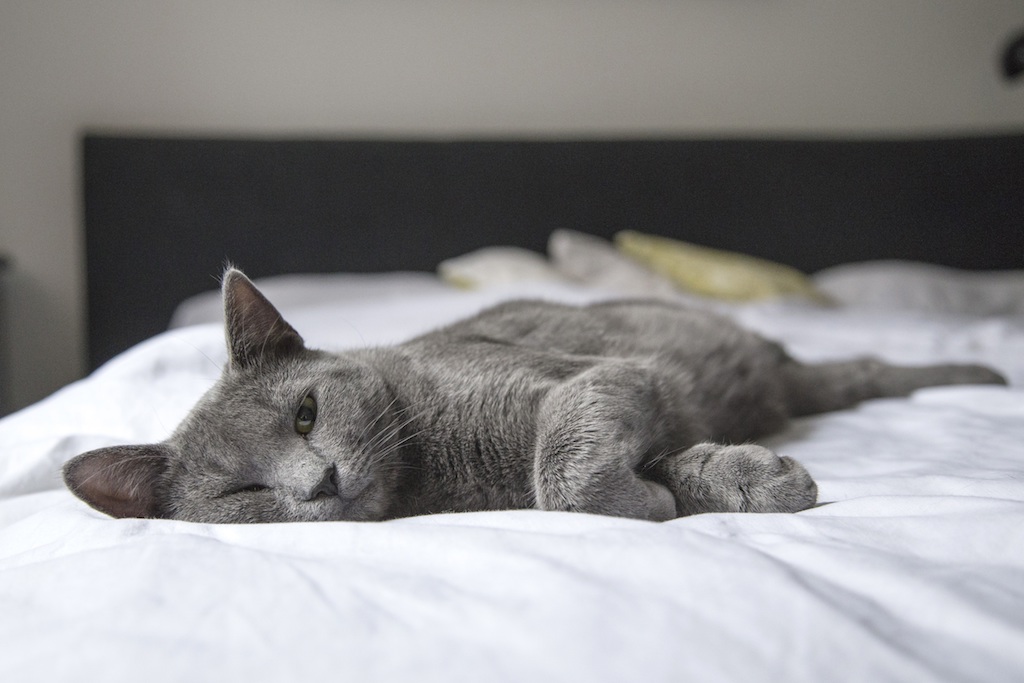
Of course, if your cat starts constantly throwing up and you can’t seem to find a cause, it’s something you should definitely look into. There are different reasons for cat vomiting and it’s important to understand what those are so you can do the right thing to help your cat.
Causes of Cat Vomiting
Overeating
This is quite a common problem in cats and I as an owner of two of these pets had to deal with this issue a few times. About a couple of months ago my cat Picas got heavily constipated and refused to eat any kind of food.
After one visit to the vet where he got some painkillers and other treatment, Picas suddenly felt the hunger rising… So, I poured some food into his bowl when we came back home. What do you think he did after all these days of dieting?
He ate the whole bowl of food in minutes without chewing, of course! A few minutes later this ended in… You guessed it. Vomiting.
Also, Picas just tends to be a greedy eater and would sometimes help himself to food from the bowl of his sister Sao! Even though I always measure the meal portion for my cats, if Picas is eating something delicious, he will swallow it without chewing and his stomach’s content will definitely end up on the floor soon after…
What to do? Your cat will be fine as long as this type of vomiting doesn’t occur multiple times a week. If your pet throws up due to overeating, don’t hurry to fill its bowl again. Let things in its stomach settle down and then try giving a smaller portion of food. In more serious cases, you should take your cat to the vet.
Hairballs
Hairballs… Yum! Not for me, of course. Many cats end up swallowing their hair while grooming themselves or their friends. Do you groom your cat’s hair as needed? No? Then don’t be surprised if your beloved one starts throwing up because of consuming its own fur.
However, this is not something dangerous or something to be too worried about. Your cat can throw up hairballs even if you are the best cat groomer in the world. It is completely normal and most catsmight experience the hairball issue now and then.
What to do? If your cat is not choking on its own hair or having difficulties getting it out from the stomach, just leave it. In serious cases you should take your kitty to the vet.
Inedibles / poison
Cats are very curious creatures and end up chewing on different inedible things such as plants, straws, strings, rubber bands, pen caps, plastic toys, etc. This can be dangerous for the pet because it can not only start to choke on larger pieces of inedible objects but it can also vomit from them.
For example, if your beloved cat swallows a string, it can end up laying inside its stomach for days, irritating it and causing frequent vomiting. If your pet is not able to get rid of the object naturally, it will probably need surgery.
There is a long list of plants that are poisonous to your cat. Once you decide to adopt a cat you must say goodbye to those plants if you want to keep your kitty safe! The good news is that there are still plenty of houseplants that are safe for cats so you can still continue to enjoy the benefits of houseplants.
When continuously consumed, poisonous things are even worse than the above mentioned indigestibles! Cats can even die from them, so you have to act ASAP if you see any signs that your pet might have swallowed something poisonous.
Cats sometimes end up eating various human medicines, cleaning chemicals, insecticides and even antifreeze. These substances can cause permanent internal organ damage or even death that will probably be very painful. No one would ever want their pet to suffer like this!

What to do? If you suspect that your cat has swallowed something inedible or poisonous and especially if symptoms worsen, go to the vet ASAP as this can be a serious threat to your pet’s life.
Allergies
Allergies are common not only in humans but also in pets. Your cat can have or develop them too. The most popular allergens that are discovered in cat food are milk, eggs, wheat, beef, and fish. If your beloved one is intolerant or allergic to any of these products, it can throw up after consuming them.
Recognizing allergy-induced vomiting might not be easy, especially if your cat never had any allergies. There could, however, be a telltale sign of an allergic reaction. You should suspect allergies as one possible cause if your pet starts vomiting from a particular type or brand of food, especially if you had recently changed it.
What to do? Prevent your cat from consuming food that contains allergens and the symptoms will subside. In extreme cases, if the allergy has turned into a serious condition and other symptoms such as shortness of breath, swollen mouth or face appear, contact the vet ASAP!
Internal parasites
A lot of kittens are born with worms in their stomach and they have to be dewormed properly to get rid of these unpleasant guests. Even though newborns are more likely to have internal parasites, healthy grown-up cats can also definitely get them too!
The most common types of parasites that can affect your cat are tapeworms, whipworms, hookworms, and roundworms. If this is the case, your pet can start vomiting frequently. Cats who have worms might also start eating more but get skinnier with time.
What to do? Take your pet to the vet. The doctor will check the cat’s stool to confirm the presence of worms. If you can, try to collect stool sample beforehand to speed up things. The vet will administer medicine to your cat to get rid of the unwanted guests.
Infections and diseases
There are different variants of viral and bacterial infections lurking around us and some of them affect cats as well. Your pet is more likely to catch such an infection if it ate something old or infected, had contact with a sick animal. The risk of infectious diseases increases for outdoor cats who come in contact with a lot more sources of diseases than indoor cats.
Nevertheless, vomiting can also be a symptom of a health condition. In some cases, kidney disease, inflammatory bowel disease (IBD), liver failure, diabetes, or even cancer can cause cat vomiting.
What to do? Treatment is needed here ASAP! Don’t hesitate to make an emergency visit to the clinic if your pet has been feeling ill overall. Some diseases can be life-threatening.
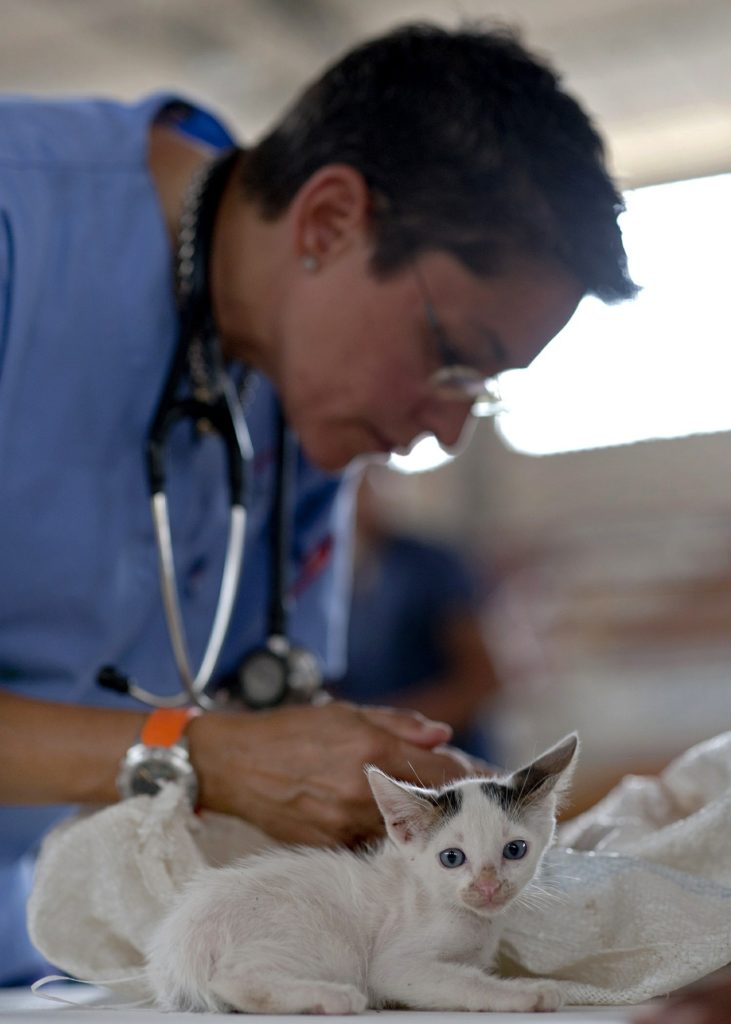
What Does the Color of Cat Vomit Tell You?
Cat vomit has all the colors in traffic lights. This should make it easy for you to remember and distinguish between each color. Let’s look at the underlying reasons for red, yellow, and green vomit.
Red
If you see this type of vomit coming from your cat’s mouth, you should take it seriously and act ASAP. The red color is often blood from the animal’s intestines which can signal a serious condition.
Yellow or brownish
This type of cat vomit usually shows up after your cat throws up the ingested food before the digestion process reaches further stages. Such vomiting can easily be caused by overeating (quick eating without chewing), consuming foods containing allergens, eating something old, etc.
Green
Not the color of the grass but still green. Did your cat just vomit in green? This means that the content came not from the stomach but from further places when the digestion process was coming to an end but wasn’t fully finished.
Prevent Cat Vomiting With These Tips
Now that you know what the possible causes for cat vomiting are, let’s see how we can prevent these unfortunate situations from happening.
Food portioning
If your beloved cat is a greedy eater, you can try feeding it smaller but more frequent food portions. That way your pet will not put too much food in its stomach which can help to prevent vomiting. Also, DON’T forget to feed your cat regularly because hungry cats are more likely to overeat and consequently throw up.
Cat grooming
Is your cat throwing up hairballs? You might not be able to prevent your cat from swallowing its hair but you can decrease the risk of hairball forming in the first place by regularly grooming your cat.
Safety first
We know it might be convenient to have some frequently needed things in easily accessible places… but this also means that your cat can reach them too! It’s better to safely hide all toxic cleaners, car liquids, and medicine so they are not within reach of pets (or kids for that matter). The same goes for inedible objects. Don’t leave any strings, ribbons, pens, buttons, and other small objects lying around. Finally, get rid of houseplants that are toxic to your cat.
Feed allergen-free food
Did your cat start vomiting when you gave it a particular brand or type of food? Try changing the food and see if this stops the vomiting. Also, you can have your cat tested for allergies at the vet to confirm if food allergies are the cause of vomiting.
Deworming
Bear in mind that you have to deworm your new cat once it arrives at your house. You can also have your cat tested to confirm if your beloved cat is worm-free. Your vet might recommend prophylactic deworming once every three to six months.
Overall health
You can prevent cat vomiting in most cases by following the above guidelines. Besides regular visits to the vet, you should make sure that your cat always gets clean, fresh water and healthy food with a high nutritional value.
Also, include daily playtimes to keep your cat active and fit as overweight cats are more likely to develop various diseases. Furthermore, get all needed vaccines, check your pet’s fur thoroughly for ticks and fleas if it goes outside. A clean, well-fed, athletic, and healthy cat is a happy cat!

